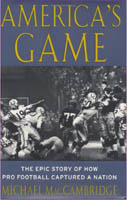“On any given Sunday, any team in our league can beat another team.” That famous adage of the National Football League is one of the most memorable and significant validations of the competitive spirit in all of sports.
In the NFL, a sense of fair play and the opportunity to excel go far beyond demonstrations of athletic ability or team spirit. “On any given Sunday” has become enshrined as one of the most successful commercial philosophies in the last half century of American business. As illustrated in a new book by Michael MacCambridge titled, America’s Game: The Epic Story of How Pro Football Captured a Nation, the rapid rise of pro football from insignificance in the 1940s to its position as the most popular and commercially lucrative sport in America by 1968 was the result of an egalitarian structure conceived by league officials and approved by team owners whose playing squads battled on the gridiron with the zeal of warriors.
MacCambridge’s book weaves accounts of pivotal NFL games, as well as character sketches of key players, coaches and commissioners, into an analysis of the way that the NFL evolved as a business entity. The league’s main adversary was Major League Baseball, which was truly America’s national pastime during the first half of the twentieth century. For more than two decades after the founding of the NFL in 1920, professional baseball so overwhelmed football in popularity that a rivalry could hardly be said to have existed between the two sports.
In large measure, the NFL’s rise to preeminence after World War II was linked to television’s coming of age. Just as television toppled motion pictures from their place as America’s most popular entertainment form, so the NFL triumphed, and for many of the same reasons. Pro football, with its fast-moving plays and game structure, was eminently suitable for the small screen. But as MacCambridge repeatedly shows, pro football’s success was due to a lot more than that. NFL leaders, particularly Pete Rozelle, the league commissioner from 1960 to 1989, understood the potential of television for pro football and developed novel techniques to exploit it in ways which their counterparts in Major League Baseball failed to do.
Rozelle is the major protagonist in the crowded field of characters in America’s Game. A consummate diplomat and manager, able to inspire cooperation among the often squabbling team owners, his greatest achievement was negotiating the merger of the NFL and its rival, the American Football League, in 1966 while retaining a healthy competition in the form of the Super Bowl game between the conference champion teams.
Even before that, however, Rozelle, a 33-year-old executive when he was elected commissioner, quickly established his credentials through adept handling of the 1964 “bidding war” among television networks for the rights to broadcast NFL games. The resulting contract with CBS, at a cost of $28.2 million for two seasons, so astonished team owners that they agreed to Rozelle’s plan to share this revenue bonanza evenly among all the teams in order to strengthen the entire league.
Rozelle’s resounding successes, however, were based on a decision made long before his tenure as commissioner began, indeed while television itself was still in its experimental stage. And the man responsible for that decision was as unlike the polished, media-savvy Rozelle as any other leader in professional sports could be.
“Blue Eagles”
De Benneville “Bert” Bell was Rozelle’s predecessor as commissioner, beginning in January 1946 when the cash-strapped NFL faced extinction in the form of a new rival league. Before that, the rough-hewn Bell had been a star player for the University of Pennsylvania and a notably unsuccessful coach and owner of the Philadelphia Eagles. Originally called the Frankford Yellowjackets, after the Philadelphia neighborhood where it played its home games, the team had gone bankrupt during the Great Depression. Bell headed a syndicate which revived the team in 1933, renaming it after the “Blue Eagle” symbol of President Roosevelt’s National Recovery Administration.
The Eagles’ abysmal playing and plummeting revenues during the 1930s made them a symbol of the troubled times in a way that squelched all Bell’s hopes and dreams. The team was so bad that Bell had trouble signing players even when he offered bonus payments from his meager resources. Yet he also derived an insight into the structure of the NFL that became the cornerstone of the league’s later success.
MacCambridge relates how Bell took the floor at a meeting of team owners in 1935 and stated: “Gentlemen, I’ve always had the theory that pro football is like a chain. The league is no stronger than its weakest link — and I’ve been a weak link for so long that I should know.”
He proposed a novel solution to redress the flagging fortunes of struggling teams in order to keep the league competitive and solvent. Later dubbed the “draft,” Bell’s plan gave the teams with the poorest records the first chance to sign the most talented college players as they became available. Surprisingly, successful big-market teams like the New York Giants and Chicago Bears agreed with Bell’s plan. Tim Mara, owner of the Giants, explained that the risk of losing gifted young players “was a hazard we had to accept for the benefit of the league, of professional football and everyone in it.”
The crucial significance of this 1935 decision can best be understood by looking at professional baseball during the same period. Baseball was dominated by the New York Yankees organization which used its financial clout to build a dynasty of champion teams from the 1920s to the 1960s. In 1929, they were briefly challenged by the Philadelphia Athletics, whose owner, Connie Mack, created a team which many sports experts regard as the greatest ever. But in a few short years, Mack had to sell most of his best players just to keep his team from folding. After World War II, the Philadelphia A’s were one of the first of many teams to relocate to a new city in order to survive.
As Major League Baseball evolved into a stratified “survival of the fittest” mode of operation, the NFL took the more egalitarian approach envisioned by Bell. Competition from rival pro football leagues worked to its advantage. During his early years as NFL commissioner, Bell faced down the All-American Football Conference, eventually accepting its best teams, like the Cleveland Browns, into the NFL. In addition, Bell worked with the owner of the Los Angeles Rams to bring pro football to the West coast a decade before baseball teams like the Brooklyn Dodgers relocated there.
Bell managed the NFL largely from his home in the Philadelphia suburb of Narberth, especially as his health declined. There is a wonderful photograph of him in the book arranging the game schedule with the names of teams on bits of paper taped onto dominoes. He died in 1959, a few months after the immortal 1958 “sudden death”
championship game between the Baltimore Colts and the New York Giants which heralded the NFL’s dominance of televised sports.
Joe Namath’s “Number One”
A new sports dynasty had arisen by 1960 and Pete Rozelle, the general manager of the Los Angeles Rams, was the perfect choice to wield its scepter. Rozelle’s first decade as NFL commissioner saw the American sports world transformed as pro football surged past baseball in popularity. His deft handling of the AFL merger prevented any divisiveness, a significant accomplishment because it paved the way for the NFL to emerge as a potent, unifying factor during the strife-torn decade of the 1960s. The League was seen as representing the best of American values, from team spirit to merit-based individualism.
Internal factors might have derailed or delayed the NFL’s ascent to glory, particularly the arrogant superiority of the old NFL teams over the AFL clubs during the intermediate period before both leagues were fully united in 1970.
When the New York Jets, a team from the AFL, stunned the sports world by beating the heavily favored Baltimore Colts in Super Bowl III in January 1969, Rozelle immediately grasped that the Jets’ victory was entirely in keeping with the NFL’s “on any given Sunday” credo. Other NFL traditionalists might have cried in their beer as the Jets’ controversial quarterback Joe Namath gave the “Number 1” signal at the end of the game, but Rozelle’s comment to a shocked NFL staffer was characteristic of his restraint and vision. “Don’t worry,” Rozelle said. “This may be the best thing that ever happened to the game.”
Rozelle worked hard to insure that the egalitarian values of the NFL were extended to the AFL clubs. Several powerful teams, such as the Pittsburgh Steelers and Cleveland Browns, were transferred to the American Football Conference, as the AFL fully merged into the league. New ventures like NFL Films and NFL Properties, the league’s merchandising unit, were organized so that all teams, regardless of their records or previous affiliation, received equal treatment. As a result, fans of a losing club could buy the same high quality posters and gear as those who rooted for the Super Bowl winner. Under Pete Rozelle, first class was the only accepted category in the NFL.
This happy state of affairs continued until the 1980s, when teams began to forsake their host cities in search of even greater chunks of revenue. This led to some truly bizarre scenarios like Los Angeles losing both of its teams, including the Rams who relocated to St. Louis which had earlier lost its own team. By the time he retired in 1989, Rozelle looked, in MacCambridge’s memorable phrase, “like a president of the United States at the end of his second term.”
Enough of the NFL’s “all for one” mentality remained for Rozelle’s replacement, Paul Tagliabue, to staunch the bleeding and keep the league at the pinnacle of the sports world. MacCambridge is optimistic about the league’s future, claiming that the NFL remains “the perfect symbol” of American values, especially of “the most American pursuit of all, those seemingly mismatched but inextricably bound ideas of competition and community.”


